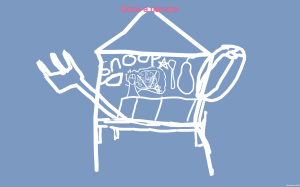I originally intended for this game to be a single player experience, but after playtesting with an improvised multiplayer mode where each player would take a turn drawing, I realized that the multiplayer was the real source of fun for the game. There was a lot of emergent behavior I would never have seen in the single player game. The players began to play cooperatively and began helping each other out with their drawings. Some began to purposefully draw in a certain way as to help the other player with their next drawing. The game turned into this strange dialogue between the players as they were both helping each other turn the same thing into two different things. There were some other emergent behaviors that I didn’t expect for individual players. When I played the game, I drew very minimally to make the next drawing easier. Seeing others play, they added a lot more detail that I would’ve added. People became very attached to their drawings in a way that I didn’t necessarily intend. People overall seemed to want more control over their drawing, so I added the ability to move the camera and zoom in and out as well as undo drawings.
For my appropriation game, the player is given a prompt to draw, which must be drawn by appropriating the previous player’s drawing. After the drawing is complete a new prompt is given to the next player. My original idea with this game was to somehow have the game mechanic be appropriation itself. In my pitch, the game mechanic was for the player to be able to explore their own creations that have been appropriated by the computer. I was inspired by a lot of the more theatrical Dada pieces, especially the earlier Zurich movement where the participation of the audience was a key part of the performance. In this game the player is key in the performance of appropriation. After making the game multiplayer, the form of appropriation transformed so that while the two players had the same object that they were appropriating, they were instructed to appropriate in two seemingly conflicting ways. With this game I saw the use of appropriation as a way to resolve these conflicts. When the players would need to turn a dog into a tree through only additional pencil strokes, there is an immediate conflict that arises. The message I wanted to send through this piece was that only through the act of appropriation by the player do they progress. Another interesting part of my game is scale. I was inspired by the use of scale as a tool for transformation such as the giant joystick or tiny hammer. I forced the player’s drawings to zoom out over time rather than just have them move along the screen.


